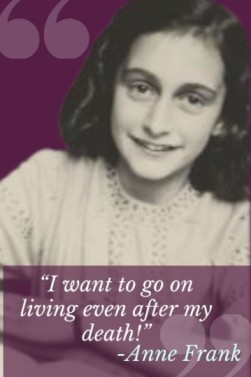Anne Frank was born on June 12th 1929 in Frankfurt, Germany. The Franks were a well-known family in the city because Anne’s father Otto had built up his own business called Opekta Works.
His company made food preservatives and other chemicals. Unfortunately, times were getting tougher for Jewish families like the Franks all across Europe, not just in Germany. The Nazi Party was growing stronger and were very against Jewish families living in their country.
Anne Frank’s love for sports
In 1933, at the age of 12, Anne joined an athletic club called, Bund Deutscher Madels (League Of German Girls). She enjoyed doing sports like swimming, gymnastics and biking.
She also liked to dance and hang out with her friends after sporting events.
She went to an all-girls school and was an average student, she struggled with math but could easily make good grades in languages.

Franks plan to move to Amsterdam
In 1938 as things were getting tougher for Jews across Europe the Franks decided to move from Germany to Amsterdam in Holland because Otto had a friend there that he knew from an old business venture, this friend offered to help him get settled there.
Anne was looking forward to the move, she knew her time of living an easy life in Germany were over. But Amsterdam would not be an easy life either because soon after the Franks moved there the Nazi aligned government took direct control of Amsterdam.
Read: Famous Quotes by Anne Frank
The Franks had made friends with an old neighbor named Mr. Dussel and an office secretary named Miep Gies. They tried to help the Franks as much as possible, but supplies were getting very scarce.
In 1942, her older sister Margot got a notice from the Nazi government that she had to report for relocation, they could no longer protect themselves or their family from being relocated.
Writing of An Inspirational Diary by Anne Frank
In July of 1942, Anne celebrated her 13th birthday and received an autograph book as a gift from her mother. She began writing in the book daily, it would be one of the only things that would survive through out the war because she hid it along with her other belongings in an old oil barrel when she got relocated to an old work building where Jews were hidden away.
In her diary, she wrote about how difficult it was to get accustomed to an air raid shelter. She missed the freedom that she had in Germany and hated being stuck in an old building day after day.
On July 16th 1944, Anne celebrated her Quinceanera in an air raid shelter with close friends and family. That same night an Allied bomb hit a nearby factory and a high explosive bomb hit the building where she had been living for an unknown period of time.
Anne’s sister Margot was relocated to Bergen-Belsen camp along with her mother Edith, younger sister Julie and an older Jewish woman named Mrs. Van Pels.
They were all transported there in September 1944, sometime after her sister’s departure Anne and her father went into hiding with an office worker named Mr. Van Pels, his son Peter and their cat for an unknown period of time.
In 1944, the Nazi Party came up with a plan to move all remaining Jews in Amsterdam. At this point, as many as 5,000 people were still alive as hidden families.
Read: Who Are Haredis and Why So Many of Them Don’t Work?
Another person who worked in the building where Anne was hiding was an architect named Mr. Kleiman, he had known her family for several years and helped them stay hidden. He offered to help find an answer for all 5,000 Jews, but there were only two places to relocate them; one location would put 400 people into an old prison and another place could put 7,000 people into an old church building.
On September 2nd 1944, Anne, her father and four other people were relocated to an annex behind an office building where they would remain hidden for over two years.
In November of 1944, a man named Victor Kugler found a place called a “Secret Annex” that was empty and used as storage for an office next door that was an illegal trading business. It was close enough to the office that they would not have to walk far in an air raid. It had an alcove next door where they could cook meals and an empty space under a set of stairs which would serve as an entrance.
On November 13th 1944, Anne got an autograph book from her parents, in it she wrote about her new living arrangements. She discussed an office party downstairs with hot chocolate and an old woman who gave them a slice of bread. She also mentioned an incident where thieves stole their groceries when they tried to get supplies for the day.
On December 4th 1944, Anne celebrated her 15th birthday in her annex location along with all the other people living there. She received a purse as a gift from an unknown admirer.
In January of 1945, Anne and her family heard over the radio that an American president had been assassinated by an American citizen. They suspected it was an inside job but they were not sure if it would mean any negative consequences for them.
On January 20th 1945 an an air raid hit an area close to Anne’s annex location but they were not relocated. This caused an accidental fire that could have been burning for up to a week.
Anne’s arrest by German officials
In the afternoon of April 10th 1945, all of the people living in the annex got an unexpected knock on their front door from two German officials who were stationed across from the building. The two officials were looking for an electrician who was not there at the time. They checked some paperwork and made an intimidating comment about an order to arrest Anne Frank.
Frank’s plan to escape
An undetermined amount of time after the men left, Mr. Frank came up with an idea that would help them escape into an alleyway without being seen by any members of the rebel army.
All the people living in the annex went into an office bathroom and turned off all lights. They stood still, trying not to breathe or make any noises for a few minutes until they heard an unknown rebel soldier enter the building.
They were able to stay completely silent as the man walked up the stairs and knocked on an office door that was not the door to their hiding place. After this an unknown number of rebel soldiers walked through an alleyway and windows but they did not see any people hiding in the building.
The only person who was observed by a soldier was an occasional employee named Mr. Kraler. He was seen walking up stairs and into an attic where he hid over 100 people.
On April 12th 1945, an official of the rebel soldiers entered an annex location and said he would be back. This forced all of the residents to begin an escape into an alleyway that took over an hour.
Early on the morning of April 13th 1945, an unknown amount of Jewish families were able to leave an office building without being seen by an unknown number of rebel soldiers.
Anne’s arrest by rebel forces
After they left an office building, an unknown amount of Jewish families were caught by an unknown number of rebel soldiers. But all except for one family was able to escape, leaving an unknown amount of people including Anne Frank, her father, and another person who did not survive the war.
How did Anne Frank die?
On Monday, August 4 , 1944, Anne Frank and her family were arrested by the Nazi secret police in an attempt to stop an illegal exchange of Jewish prisoners.
On Tuesday, August 5 , Anne Frank and her family arrived at an Auschwitz-Birkenau extermination camp .
Anne was selected for hard physical labor, but she had to abandon the effort after only a few weeks.
She later entered an illness in the camp hospital, where she died of typhus fever on March 20 , 1945 .
Anne Frank’s rise to fame.
Anne Frank was an inspiring personality of the 1930’s and 1940’s. She lived a great life until her end. During Anne Frank’s life she became an inspiration to many people with her diary about hiding from the Nazis during World War II.
Her family was hiding in an Annex located in an old office building, but were found by the Nazis. From that point, Anne Frank kept a diary under the name Anne Frank which she wrote until August 4, 1944 when they got arrested.
At what age did Anne Frank die?
Anne Frank’s family was seperated to different concentration camps where Anne died in March of 1945 at the age of 15.
How does Anne Frank’s diary inspire us?
Diary by Anne Frank has been an inspiration to many people. Her diary has inspired many people to stand up for themselves.
What is Anne Frank’s diary about?
Anne Frank stayed strong throughout an entire war without giving up, which she wrote in her diary about “Never Give Up” and that made an impact on many lives.
Conclusion
Anne Frank’s diary is a diary that many people have heard of. Anne Frank kept a diary of an entire war and stayed strong.
You can visit Wikipedia to learn more about Anne Frank.
An Inspirational Diary by Anne Frank Before Dying at Age 15 inspires us to stay strong and never give up even in the hardest times we face.
Recent Articles:
- Master Self-Discipline: Transform Your Life in 2025 with These Essential Strategies!
- Ebook Design for Children’s Books: Capturing Young Minds Visually
- Expanding on the Value of Professional Fashion Design Services
- Get Custom African American Character Illustrations with Any Hairstyle
- Transform Your Look with Rasaline’s Expert Hairstyle and Fashion Advice






